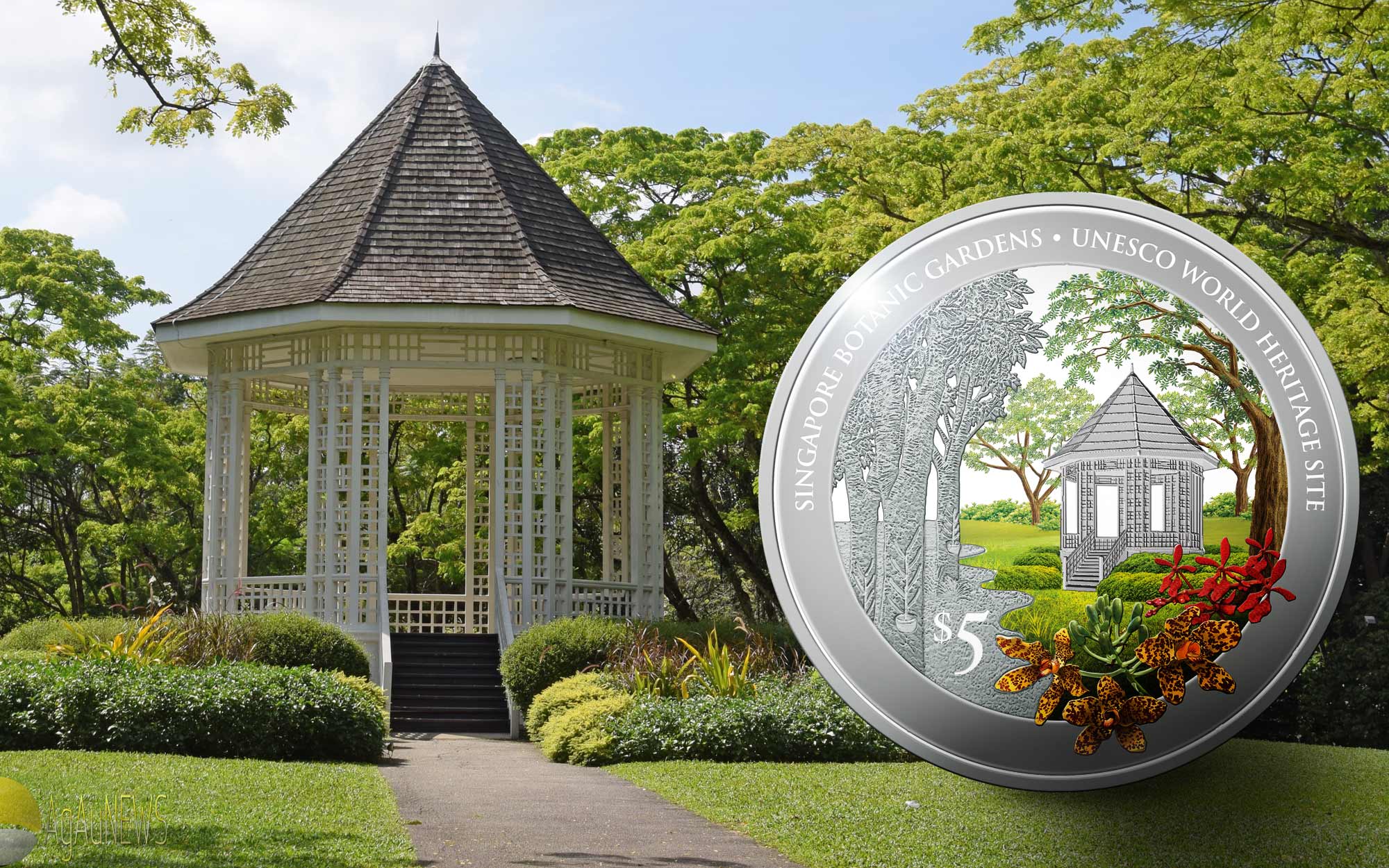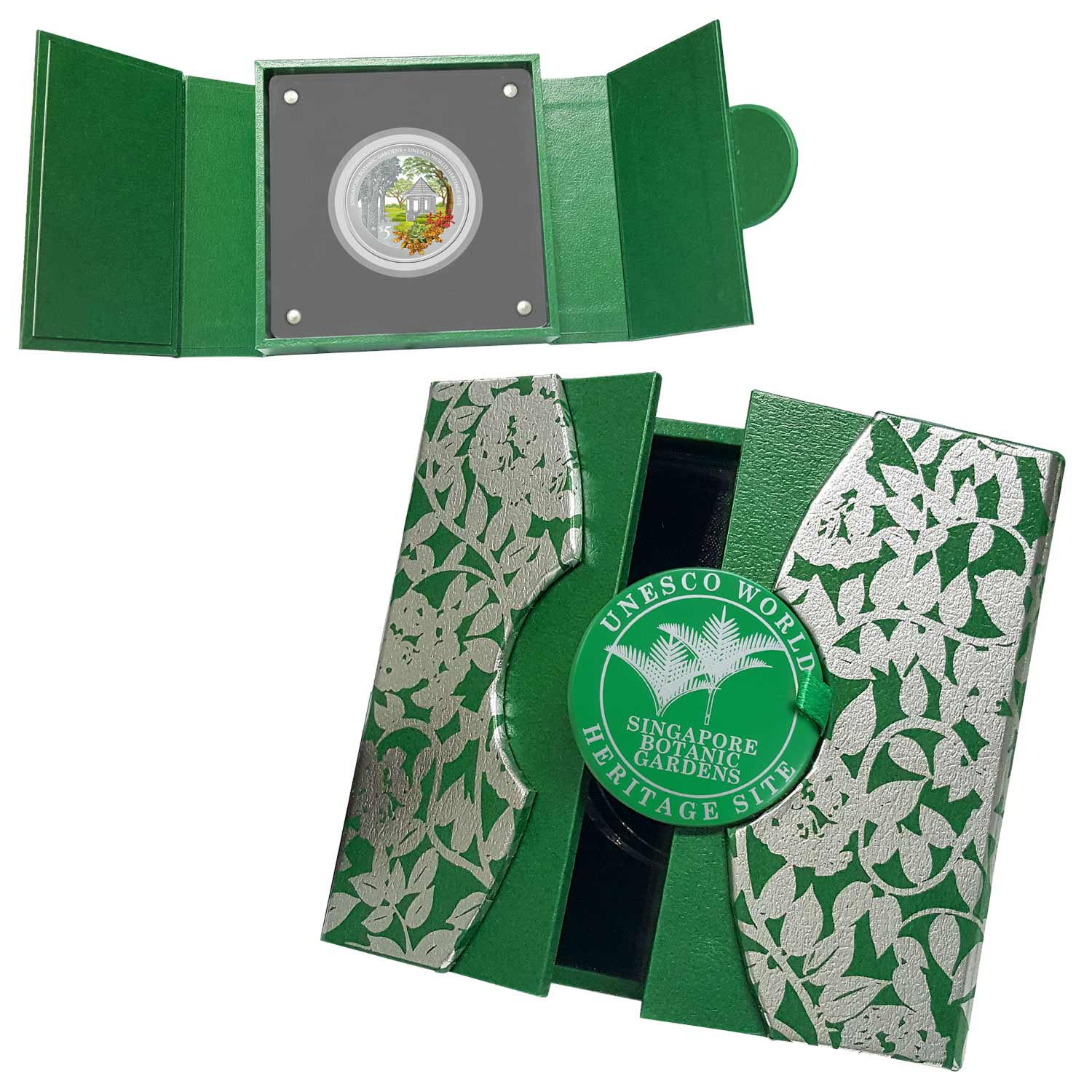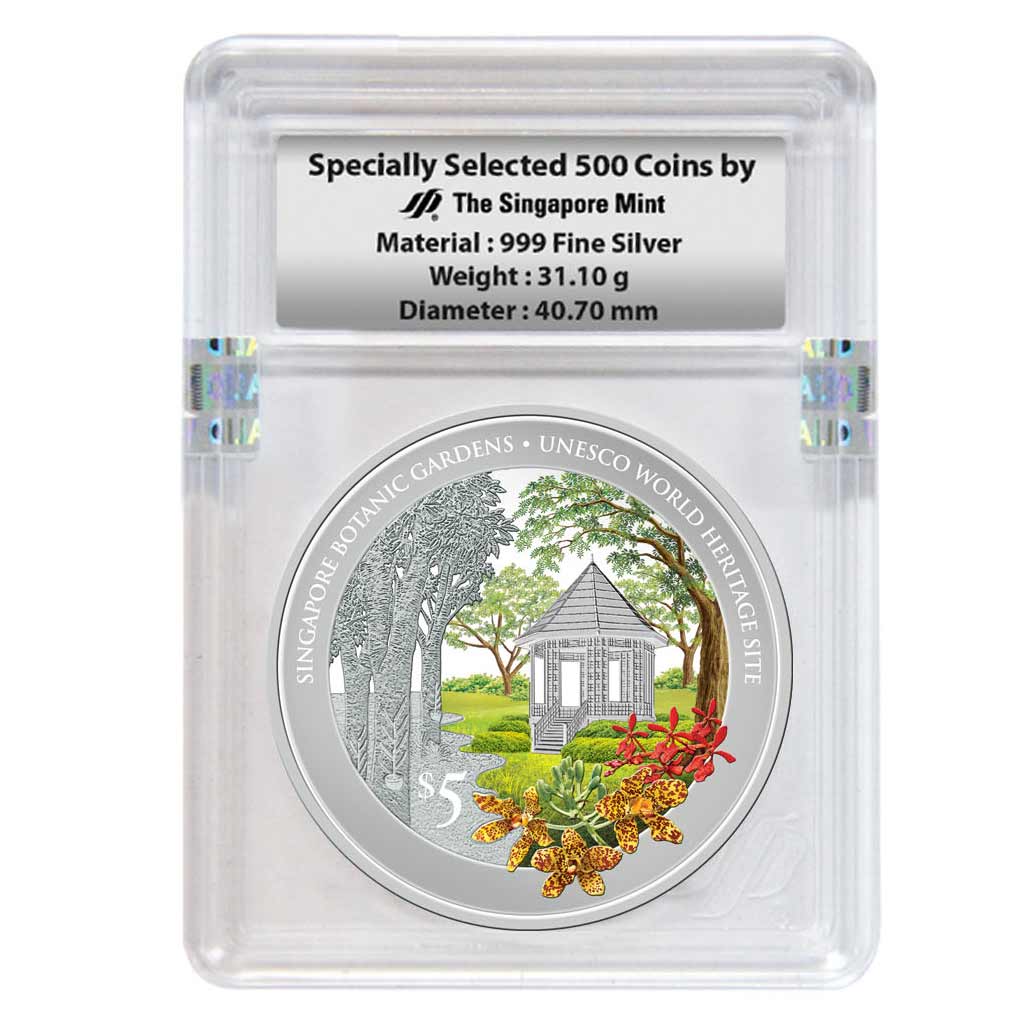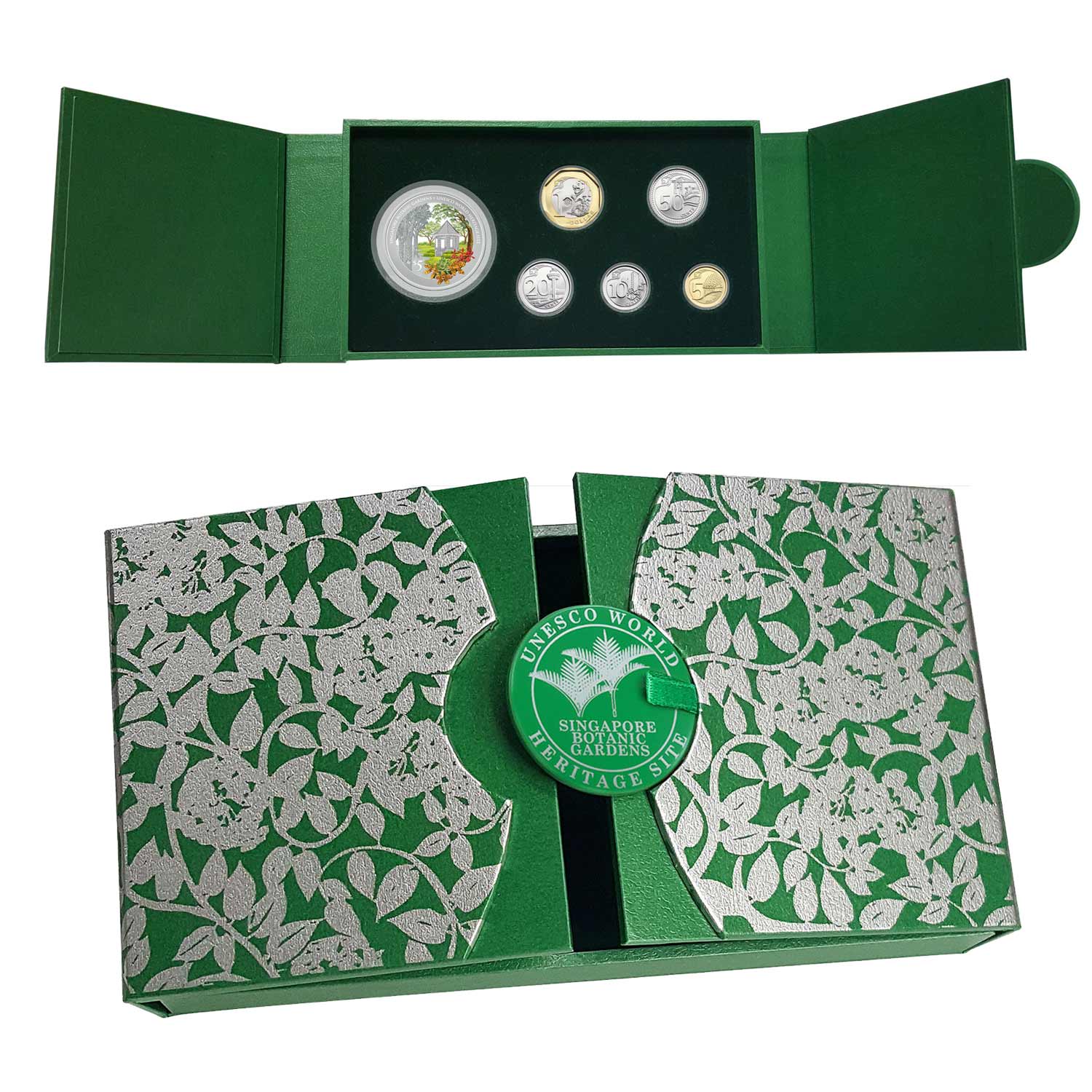Silver coin marks the Singapore Botanical Gardens new UNESCO status.
Singapore has long had a love for its botanical spaces, no doubt a result of the high population density. Having lost 95% of its historical forest areas, over half of the naturally occurring flora and fauna now reside in nature reserves. In 1967 the Singapore government introduced measures to make the country a garden city and since then almost a tenth of Singapores area has been set aside for parks and gardens.
The Singapore Mint has long lauded its botanical heritage with a succession of coins celebrating the orchids for which this tiny state is well known, it being the national flora. Orchids are again a part of this design, even though the focus is on the botanical garden itself. This quite beautiful park was last year awarded UNESCO World Heritage status, a highly prestigious mark that only two other gardens in the world have ever been honoured with.
Struck in an ounce of fine silver and selectively coloured, it’s a nice look at the gardens, showing potentially good levels of detail (we’ve yet to see an actual coin) and a subtle use of colour. The Tiger Orchid is heavily featured, the first one being planted in 1861 still being there today. The obverse carries the emblem of Singapore with the nations name around the rim in four languages. It’s a style that follows that of the various orchid series quite closely and would make a fine companion piece.
There are three ways to buy the coin. The coin is available on its own in a themed box (12,500 at S$130.00), and in a similar, larger box along with as set of circulating coins (2,000 at S$145.00). The final 500 pieces are sold in a slab similar to those used by the NGC/PCGS grading services. The mint selects these for being of the best quality, but they’re not graded per se. That doesn’t prevent them being very highly sought after and the run of 500 sold out almost immediately with balloting taking place to determine which buyers will recieve one. Available now direct from the mint, or from site sponsor Powercoin who have them for €99.95.
2016 SINGAPORE BOTANICAL GARDENS PROOF SILVER COIN
MINTS DESCRIPTION
The Singapore Botanic Gardens (SBG) was inscribed into the list of UNESCO World Heritage Sites on 4 July 2015. It is the only tropical botanic garden in the world to be inscribed into the list. In celebration of this historic achievement, the Monetary Authority of Singapore is proud to present the Singapore Botanic Gardens UNESCO World Heritage Site Commemorative coin.
This coin, issued in 1 troy oz 999 Fine Silver Proof Colour, showcases various elements that contributed to the success of SBG’s inscription as an UNESCO World Heritage Site, namely;
a) A cluster of rubber trees with herringbone incisions, V-shaped cuts which allow the bark of the tree to be reopened for tapping of latex at regular intervals without causing harm to the tree, is depicted on the left of the coin to signify SBG’s contribution to the commercial success of rubber in the region;
b) The Bandstand, one of the best known features of SBG, is portrayed with accompanying yellow rain trees at the centre;
c) Sprays of Renanthera Singapore Botanic Gardens and Grammatophyllum speciosum, commonly known as the Tiger orchid, line the bottom of the coin. These two species of orchids were selected given their significance to SBG. The Renanthera SBG showcases SBG’s world renowned orchid hybridisation programme that was established in the 1920s while the Tiger Orchid represents SBG’s long history in orchid cultivation, with the first specimen planted in 1861 still existing today at 155 years of age.
3 The elements are featured in vibrant colours and intricate engravings against a shiny surface, within an outer sandblasted rim. The obverse of the coin bears the Singapore Coat of Arms with the year 2016.
VARIOUS PACKAGING OPTIONS
SINGAPORE BOTANIC GARDENS
The Singapore Botanic Gardens is a 156-year-old tropical garden located at the fringe of Singapore’s main shopping belt. It is one of three gardens, and the only tropical garden, to be honored as a UNESCO World Heritage Site. The Botanic Gardens has been ranked Asia’s top park attraction since 2013, by TripAdvisor Travellers’ Choice Awards. It was declared the inaugural Garden of the Year, International Garden Tourism Awards in 2012, and received Michelin’s three-star rating in 2008.
The Botanic Gardens was founded at its present site in 1859 by an agri-horticultural society. It played a pivotal role in the region’s rubber trade boom in the early twentieth century, when its first scientific director Henry Nicholas Ridley, headed research into the plant’s cultivation. By perfecting the technique of rubber extraction, still in use today, and promoting its economic value to planters in the region, rubber output expanded rapidly. At its height in the 1920s, the Malayan peninsula cornered half of the global latex production.
The National Orchid Garden, within the main gardens, is at the forefront of orchid studies and a pioneer in the cultivation of hybrids, complementing the nation’s status as a major exporter of cut orchids. Aided by the equatorial climate, it houses the largest orchid collection of 1,200 species and 2,000 hybrids.
Early in the nation’s independence, Singapore Botanic Gardens’ expertise helped to transform the island into a tropical Garden City, an image and moniker for which the nation is widely known. In 1981, the hybrid climbing orchid, Vanda Miss Joaquim, was chosen as the nation’s national flower. Singapore’s “orchid diplomacy” honors visiting head of states, dignitaries and celebrities, by naming its finest hybrids after them; these are displayed at its popular VIP Orchid Gardens.
Singapore’s botanic gardens is the only one in the world that opens from 5 a.m. to 12 midnight every day of the year. More than 10,000 species of flora is spread over its 82-hectares area, which is stretched vertically; the longest distance between the northern and southern ends is 2.5 km (1.6 mi). The Botanic Gardens receives about 4.5 million visitors annually. (Source: Wikipedia)
THE COINS FEATURED ELEMENTS
BANDSTAND: An iconic landmark of the Singapore Botanic Gardens, the Bandstand is a representation of the Gardens as a social venue since its early years, where the locals gather for concerts and celebrate personal milestones. The octagonal gazebo, erected in 1930, served as a site for regimental bands to perform.
The Gardens was the ‘neutral’ meeting place for families to introduce partners in former arranged marriages; in 1959, it was the venue for a series of multi-cultural concerts where Malay, Chinese and Indian performances shared the stage for the first time; and a series of events that shaped the formation of the multi-racial culture in Singapore.
RUBBER TREES WITH HERRINGBONE INCISIONS: The rubber trees with herringbone incisions symbolise the contributions of the Singapore Botanic Gardens to the rubber boom in Southeast Asia which transformed the face of the regional economy. The development of innovative rubber cultivation techniques and herringbone incision was pioneered by the first Gardens Director Henry Ridley and his team of managers. The shallow herringbone incisions were revolutionary as its V-shaped cuts allowed the bark of the tree to be reopened at regular intervals, allowing latex to be obtained continuously from the same tree throughout most of the year, without causing permanent harm to the trees. This greatly increased the productive lifespan of the rubber trees and latex yield during the years of rubber boom.
ORCHID HYBRIDISATION: A cradle of breeding science for orchids, Singapore Botanic Gardens has successfully developed many orchid hybrids. The Orchid Hybridisation Programme established in 1928, by Singapore Botanic Gardens together with local breeders, has created and produced exotic hybrids which were highly popular in the orchid cut-flower industry. Exports of hybrids boosted Singapore’s flower export industry and brought in S$13-16 million annually during the late 1970s and early 1980s.
RENANTHERA SINGAPORE BOTANICAL GARDENS: The Renanthera Singapore Botanic Gardens was named in 1999 to commemorate the 140th Anniversary of the Gardens. This magnificent plant carries branching, fan-shaped sprays. It was awarded the First Prize and the Trophy for the best Renanthera hybrid at the 17th World Orchid Conference in 2002.
TIGER ORCHID: The Grammatophyllum speciosum Tiger Orchid is amongst the most remarkable specimens in the Garden’s collections with great significance in the history. Planted in 1861 by designer of the Gardens, Lawrence Niven, the native specimen may likely be the world’s oldest and largest specimen, at 155 years of age and five metres in diameter as of 2016. The Tiger Orchid is the world’s largest orchid species, whose common name refers to the tiger-striped flowers.
SPECIFICATION
| DENOMINATION | COMPOSITION | WEIGHT | DIAMETER | FINISH | MINTAGE | BOX / COA |
|---|---|---|---|---|---|---|
| $5 SINGAPORE | 0.999 SILVER | 31.1 g | 40.7 mm | PROOF | 15,000 | YES / YES |













Leave A Comment